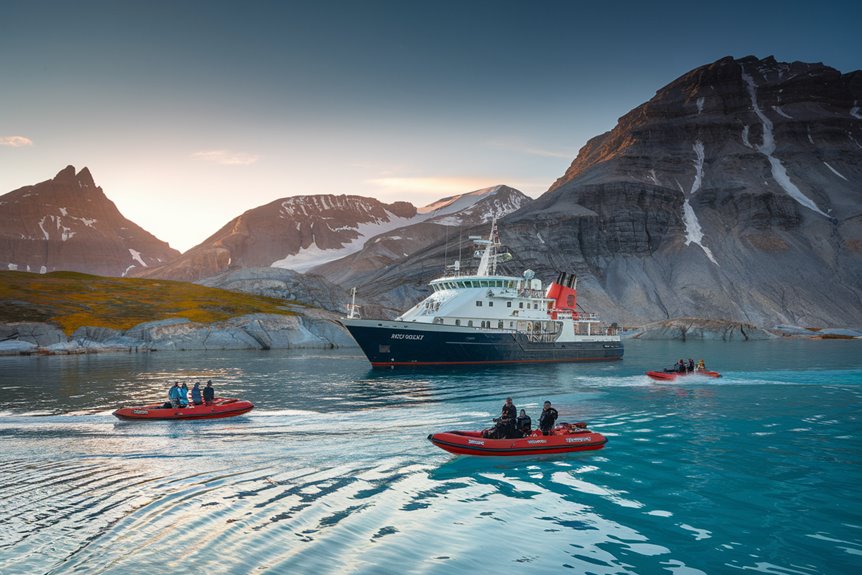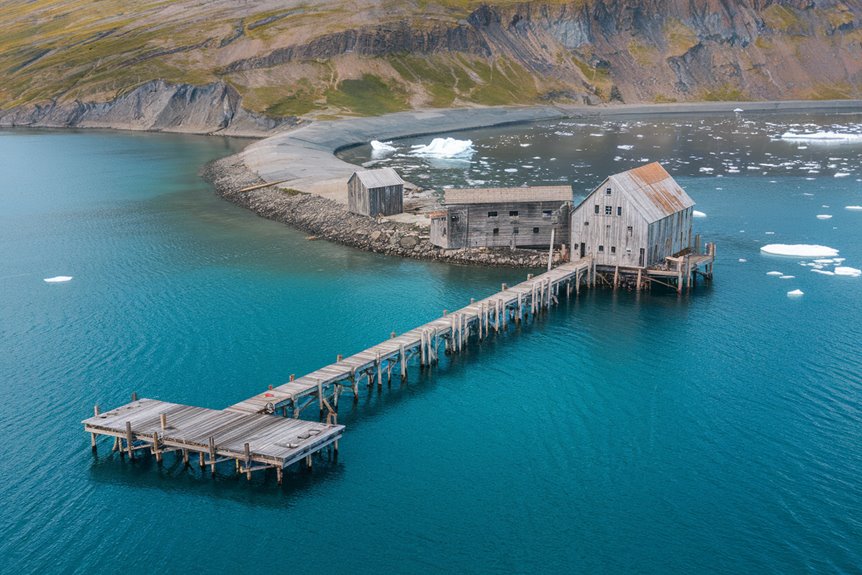Your ship docks at Pauline Cove, a sheltered harbour on Herschel Island’s west side. You need advance permits and vessel clearance for this Arctic destination. The summer temperature hovers around 13°C, so you must bring Arctic-grade clothes like waterproof jackets and thermal wear.
For other Canada Cruise destinations check out our Canada Cruise Ship Ports Guide page.
The island offers rich wildlife viewing. You can spot beluga whales, polar bears and seals during guided shore trips. The site features Canada’s oldest wooden structure and showcases important Inuvialuit heritage. You must follow strict conservation guidelines to protect this special Arctic location.
During your visit, you’ll explore both natural and historical attractions. The former whaling station holds significant cultural value, whilst the surrounding Arctic landscape provides a unique wilderness experience.
🐧 Polar Cruise Enquiry 🐻❄️
Our team of polar travel specialists have personally explored both the Arctic and Antarctic regions – from tracking polar bears in Svalbard to kayaking with penguins off the Antarctic Peninsula. Let us find the right polar expedition cruise for you.
Getting to Herschel Island

You can reach Herschel Island from mid-June to mid-September through two main routes: air and sea.
Air Travel:
- Book a charter flight from Inuvik, Northwest Territories
- Get your park permit before landing
- Contact local operators for flight arrangements
Sea Travel:
- Take a Northwest Passage cruise ship to Pauline Cove
- Book a boat charter from Mackenzie Delta towns
- End a Firth River rafting or kayaking trip at the island
Travel Tips:
- Pack extra food and supplies
- Plan for weather delays, especially late summer fog
- Book your return journey in advance
- Stay flexible with your schedule
This remote Arctic destination sits in the Beaufort Sea off Canada’s northern coast.
Weather conditions often change quickly, so you’ll need to stay prepared for schedule adjustments.
Pauline Cove Port Details

Pauline Cove welcomes you to a historic Arctic port on Herschel Island’s western coast. You’ll find the cove has transformed from its whaling industry past into a seasonal cruise ship destination.
You can dock or anchor where whaling vessels gathered in the 1890s. The port once supported 1,500 residents during its peak whaling period. The Community House, dating from 1893, now serves as your main point of contact, housing the visitor centre and park office.
Your basic visitor services remain modest, yet you can access several well-preserved historic structures. The port area lets you:
- Take scenic hikes
- Watch for Arctic wildlife
- Visit archaeological sites
You’ll experience a distinctive mix of cultures, as the port combines Inuvialuit traditions with whaling history. The Yukon Government and Inuvialuit people jointly manage the site, ensuring its preservation for visitors like you.
Weather and Best Times

Weather in Herschel Island follows a dry-winter tundra pattern with clear seasonal changes.
You’ll experience winter temperatures as low as -50°C, while summer temperatures stay mild at around 13°C. Ice covers the island from November to early June, and strong winds blow throughout the year.
You can best visit the island in August when cruise ships have ice-free access.
The island offers 24-hour daylight between 19 May and 24 July, making it perfect for spotting wildlife and Arctic flowers.
You should avoid visiting during the polar night (29 November to 14 January) when darkness covers the island.
Your travel plans might need flexibility, as fog and ice can affect ship access.
The island faces ongoing changes from climate impact, with its coast eroding by up to 3 metres each year.
Essential Gear to Pack

Essential Arctic Gear Checklist
You need specialised gear to visit Herschel Island safely in the Arctic environment.
Clothing:
- Waterproof, insulated jacket and trousers
- Thermal base layers
- Arctic-rated boots
- Insulated gloves
- Warm hat and scarf
- Protective goggles
Safety Equipment:
- Arctic first aid kit
- Emergency shelter
- Satellite phone
- GPS device
- Bear deterrent spray
- Local area maps
Camp Gear:
- Arctic-rated tent
- Portable camping stove
- Water purification tablets
- Cooking equipment
- Food supplies for your stay
- Extra drinking water
Exploration Tools:
- Binoculars
- Camera
- Hiking poles
- Snowshoes (for winter visits)
You’ll find this gear essential for your safety and comfort in the harsh Arctic conditions.
Pack each item carefully and test your equipment before departure.
Cultural Heritage and History

When you visit Herschel Island, you’ll find fascinating layers of cultural history.
The Community House, built in 1893, stands as Yukon’s oldest wooden building and serves as your visitor centre today. You can explore its exhibits that tell two main stories: the Inuvialuit people’s traditional hunting and fishing practices, and the whaling industry that brought dramatic changes to Pauline Cove.
The island once hosted a bustling whaling station where 1,500 people lived and worked in the late 1800s. You’ll see how these two cultures – the Indigenous Inuvialuit and Euro-American whalers – shaped the island’s unique heritage.
Historic Whaling Community Life
Herschel Island’s whaling community started in 1889 and grew to 1,500 residents. You’d have found most people living on whaling ships, whilst others stayed in buildings around Pauline Cove.
The community brought together three main groups: American whalers, Inuvialuit people and North Alaskan labourers.
The whalers harvested these key products:
- Baleen from bowhead whales to make corsets and umbrellas
- Blubber to create heat and light
- Whale oil for industrial purposes
- Whale bones to craft household items like shoe horns
Missionaries arrived in the mid-1890s and changed the community’s social structure.
You’d have seen the impact of European diseases spreading through the population. The whaling industry ended when manufacturers created synthetic materials to replace baleen.
Indigenous Cultural Heritage Sites
Discover ancient Thule settlements on Herschel Island, dating back 1,000 years. You can find their archaeological remains and artefacts scattered across the island today.
Two major sites, Pauline Cove and Avadlek Spit, show you how indigenous communities lived and developed over time.
Climate change now threatens these historic sites. You can see the damage from rising seas, thawing permafrost and coastal storms.
Modern Inuvialuit people maintain strong connections to the island. You’ll find them using the land for traditional hunting and fishing, working alongside the Yukon government to protect their heritage.
You can explore these sites to understand the rich indigenous history of the region, but time is limited as erosion continues to affect these valuable cultural locations.
Preserved Community House Significance
The Community House at Pauline Cove stands as Yukon’s oldest frame building. You can find this historic structure on a gentle slope, carefully preserved since its construction in 1893. The building arrived as pre-made parts from San Francisco and has maintained its excellent condition through the decades.
You’ll discover a versatile building that has served many purposes:
- A Pacific Steam Whaling Company facility (1893-1896)
- An Anglican Church (1896-1906)
- A Royal North-West Mounted Police post (1911 onwards)
- A modern park office and visitor centre
The building holds special meaning for different groups:
- You can trace its history as a meeting point for Inuvialuit people, whalers and traders.
- You’ll recognise its ongoing role in seasonal harvesting.
- You can see its continued use for community gatherings.
The structure’s remarkable preservation and adaptability have made it one of Yukon’s most treasured architectural landmarks.
You can now visit this building to experience a direct connection to over 100 years of northern Canadian history.
See what’s on offer from the Smoking Hills, Cape Bathurst, Northwest Territories, Canada for a different Canada Cruise destination.
Wildlife Viewing Opportunities

You can spot amazing wildlife on Herschel Island all year round.
Marine Life:
- Watch bowhead whales migrate to the Bering Sea in September
- See beluga whales during ice-free periods
- Find ringed seals near ice edges
- Spot polar bears hunting seals
Land Animals:
- Track Porcupine caribou herds in summer
- Look for muskoxen in open areas
- Watch for grizzly bears across the terrain
- Find arctic and red foxes near their dens
Birds:
- Visit the largest black guillemot colony in the western Arctic
- Observe arctic terns around tundra ponds
- See snow buntings along the beaches
Small Animals:
- Find lemmings in grassy areas
- Spot tundra voles in vegetated zones
- Watch for arctic shrews across the island
The clear separation and simple structure make it easier to identify which wildlife you can expect to see in each habitat.
Local Rules and Regulations

You need a park permit to visit Herschel Island.
The island has strict visitor limits, so check the allowed numbers before your trip.
Keep a safe distance from wildlife and avoid disturbing animals in their natural habitat.
When you visit cultural sites, follow the preservation rules carefully.
These protect both physical artefacts and respect the Inuvialuit people’s traditional use of the area.
Permit and Access Requirements
Getting to Herschel Island requires specific permits and documents:
You need:
- A wilderness tourism licence
- A Yukon park use permit
Contact parkpermits@gov.yk.ca to apply for these at least six months before your visit.
Your vessel requires screening by the Inuvialuit Regional Corporation and Game Council.
Required vessel certificates:
- International Ship Security Certificate
- Safety Management Certificate
- Pollution Clean-Up Indemnity Certificate
- Recent Port State Control Inspection Report
Transport Canada rules apply to your vessel:
- You must have proper ice classification
- You must meet Safety Control Zone standards
Park staff will check your vessel before you can disembark. They’ll guide you on protecting the environment during your visit.
Remember:
- Submit all applications early
- Keep certificates up to date
- Follow staff guidance on-site
Wildlife Protection Guidelines
You must follow key wildlife protection rules when visiting this Arctic sanctuary. Keep a safe distance from all animals and never feed them. Stick to designated areas to protect sensitive habitats and nesting sites.
Wildlife viewing has specific guidelines to keep animals undisturbed. You should:
- Turn off your camera flash near wildlife
- Keep your voice low when watching animals
- Follow ranger instructions immediately
- Stay on marked paths at all times
The park’s ecosystem needs your help to stay protected. Rangers monitor these rules to ensure wildlife remains safe and undisturbed.
These guidelines come from the Inuvialuit Final Agreement and help preserve the sanctuary for future visitors.
Cultural Site Preservation
Cultural Heritage Guidelines at Herschel Island
You need to follow specific rules to protect the island’s cultural sites under the Inuvialuit Final Agreement and park laws.
Stay in marked visitor zones to help preserve historic buildings affected by:
- Rising sea levels
- Melting permafrost
- Coastal erosion
- Flooding
Essential rules for your visit:
- Leave all artifacts where you find them – they’re protected by law
- Keep away from raised or moved historic buildings
- Listen to park rangers about restricted cultural areas
- Stay clear of ongoing conservation work
You’ll notice regular preservation activities around the park.
Buildings undergo frequent lifting and moving to protect them from environmental damage.
The park team actively monitors all historic structures to spot early signs of wear or damage.
Remember: Your careful actions help preserve these important cultural sites for future visitors.
Shore Excursion Highlights

Shore excursions on Herschel Island start at Pauline Cove on the western coast. You’ll step onto the tundra for guided walks that showcase both wildlife and history.
The waters around the island offer views of beluga and bowhead whales swimming in the Beaufort Sea. You might spot polar bears wandering the shoreline, and walruses and seals often appear near the coast. The cliffs provide perfect spots to watch Arctic birds soar overhead.
You can visit historic cabins that tell stories of the island’s past. These buildings house items from the whaling and trading days, showing you how the Inuvialuit people lived and how early Arctic explorers survived here.
Each trip ashore combines nature watching with discoveries about the island’s rich heritage. You’ll get close to Arctic wildlife while learning about this unique northern outpost.
Frequently Asked Questions
Are There Any Medical Facilities or Emergency Services on the Island?
Herschel Island has no medical facilities or emergency services available. You must carry a satellite phone for emergencies. The closest medical help is located in Inuvik, 250 kilometres away.
Can Passengers Collect Rocks, Plants, or Artifacts as Souvenirs?
Taking rocks, plants or artefacts from Herschel Island-Qikiqtaruk is not allowed. You need to leave all natural and cultural items exactly where you find them. This rule helps protect the island’s environment and heritage. Taking any items from the island will result in fines or other penalties. You can take photos instead to remember your visit.
Is There Cell Phone or Internet Service Available on Herschel Island?
You won’t find any mobile phone or internet service on Herschel Island. If you need to stay connected during your visit, you should arrange satellite communication before your trip. The island’s remote location means you’ll experience complete digital disconnection, letting you focus fully on the natural surroundings.
Do Local Inuvialuit Guides Accompany Cruise Ship Shore Excursions?
Local Inuvialuit guides will join you on all shore excursions. You’ll benefit from their traditional knowledge and cultural insights whilst exploring the area. These guides ensure your visit respects local customs and follows regional regulations. You’ll learn directly about the community’s way of life and discover unique details about the island’s environment that only locals know.
What Currencies Are Accepted for Purchases on the Island?
You’ll need Canadian dollars for most purchases on the island. US dollars are accepted by some vendors, but at varying exchange rates. The Community House accepts major credit cards. Keep cash on hand, as there’s no ATM available on the island.
Thinking about something different? Check out the cruises leaving from Tuktoyaktuk, Northwest Territories, Canada.
🐧 Polar Cruise Enquiry 🐻❄️
Our team of polar travel specialists have personally explored both the Arctic and Antarctic regions – from tracking polar bears in Svalbard to kayaking with penguins off the Antarctic Peninsula. Let us find the right polar expedition cruise for you.
